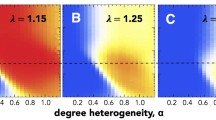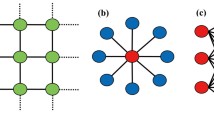Abstract
The study of evolutionary games on networks has revealed the impact of population structure on evolutionary dynamics. Unlike the case in well-mixed population where defection is favored by natural selection, certain types of networks have shown to favor cooperation. However, most previous research work has been focusing on frequency-based analysis, and emphasized on the update strategy adopted by each player, and thus generally considered the group of players with the same strategy as a whole. While it is powerful in deriving analytic results using this approach, the heterogeneity of players within such groups is effectively overlooked. In this paper, we attempt to emphasize more on the heterogeneity of players that comes from the network structure in evolutionary dynamics. Particularly, the prestige of a player is represented by its centrality, and it is reflected in an adapted payoff function. We provide several viable centrality measures that can be calculated using the adjacency matrix of the network. The relation between different centrality measures of the invader and the fixation of cooperation is analyzed via computational simulations. Results show that in the proposed model, compared to other three centrality measures, invaders with maximum betweenness centrality have significant advantage in terms of the fixation probability of cooperation, in both scale-free and small-world networks.








Similar content being viewed by others
References
Abramson G, Kuperman M (2001) Social games in a social network. Phys Rev E Statist Phys Plasmas Fluids Related Interdiscip Top 63(3):1–4
Allen B, Lippner G, Chen YT, Fotouhi B, Momeni N, Yau ST, Nowak MA (2017) Evolutionary dynamics on any population structure. Nature 544(7649):227–230
Amaral MA, Javarone MA (2018) Heterogeneous update mechanisms in evolutionary games: mixing innovative and imitative dynamics. Phys Rev E 97(4):16–18
Assenza S, Gómez-Gardeñes J, Latora V (2008) Enhancement of cooperation in highly clustered scale-free networks. Phys Rev E Statist Nonlinear Soft Matter Phys 78(1):1–5
Axelord R, Hamilton WD (1981) The evolution of cooperation. Science 211:1390–1396
Bonacich P (2012) Power and centrality: a family of measures. Am J Sociol 92(5):1170–1182
Barabasi A, Albert R (1999) Emergence of scaling in random networks. Science 286(5439):509–512
Benzi M, Klymko C (2015) On the limiting behavior of parameter-dependent network centrality measures. SIAM J Matrix Anal Appl 36(2):686–706
Borgatti SP (2005) Centrality and network flow. Soc Netw 27(1):55–71
Chen YT, McAvoy A, Nowak MA (2016) Fixation Probabilities for Any Configuration of Two Strategies on Regular Graphs. Scientific Reports, 6
Cimini G (2017) Evolutionary network games: equilibria from imitation and best response dynamics. Complexity 2017:1–14
Grinstead CM, Snell JL (1997) Introduction to probability. American Mathematical Society, Providence
Hamilton WD (1964) The genetical evolution of social behaviour. I. J Theor Biol 7:1–16
Hauert C, Nowak MA, Lieberman E (2005) Evolutionary dynamics on graphs. Nature 433(7023):312–316
Konno T (2011) A condition for cooperation in a game on complex networks. J Theor Biol 269(1):224–233
Li C, Zhang B, Cressman R, Tao Y (2013) Evolution of cooperation in a heterogeneous graph: fixation probabilities under weak selection. PLoS ONE 8(6):2–7
Lien JW, Charness G, Zhang B, Li C, Yang C-L (2018) Endogenous rewards promote cooperation. Proc National Acad Sci 115(40):9968–9973
Nanda M, Durrett R (2017) Spatial evolutionary games with weak selection. Proc National Acad Sci 114(23):6046–6051
Negre CFA, Morzan UN, Hendrickson HP, Pal R, Lisi GP, Loria JP, Rivalta I, Ho J, Batista VS (2018) Eigenvector centrality for characterization of protein allosteric pathways. Proc National Acad Sci 115(52):E12201 LP–E12208
Newman M (2010) Networks: an introduction. Oxford University Press, Oxford
Nowak MA (2006) Five rules for the evolution of cooperation. Science 314(5805):1560–1563
Nowak MA, Fu F, Tarnita CE, Antal T, Ohtsuki H (2009) Strategy selection in structured populations. J Theor Biol 259(3):570–581
Nowak MA, May RM (1992) Evolutionary games and spatial chaos. Nature 359(6398):826–829
Ohtsuki H, Hauert C, Lieberman E, Nowak MA (2006) A simple rule for the evolution of cooperation on graphs and social networks. Nature 441(7092):502–505
Ohtsuki H, Nowak MA (2006) The replicator equation on graphs. J Theor Biol 243(1):86–97
Santos FC, Pacheco JM, Lenaerts T (2006) Evolutionary dynamics of social dilemmas in structured heterogeneous populations. Proc National Acad Sci 103(9):3490–3494
Santos FC, Rodrigues JF, Pacheco JM (2005) Epidemic spreading and cooperation dynamics on homogeneous small-world networks. Phys Rev E Statist Nonlinear Soft Matter Phys 72(5):1–5
Smith JM (1982) Evolution and the theory of games. Cambridge University Press, Cambridge
Smith JM, Price GR (1973) The logic of animal conflict. Nature 246:15–18
Szabó G, Fáth G (2007) Evolutionary games on graphs. Phys Rep 446(4–6):97–216
Taylor PD, Day T, Wild G (2007) Evolution of cooperation in a finite homogeneous graph. Nature 447(7143):469–472
Tomassini M, Luthi L, Giacobini M (2006) Hawks and Doves on small-world networks. Phys Rev E Statist Nonlinear Soft Matter Phys 73(1):016132
Trivers RLBY (1971) The evolution of reciprocal altruism. Quarterly Rev Biol 46(1):35–57
Watts DJ, Strogatz SH (1998) Collective dynamics of ‘small-world’ networks. Nature 393(June):440–442
Wilhite A (2014) Network structure, games, and agent dynamics. J Econ Dyn Control 47:225–238
Wu J-J, Li C, Zhang B-Y, Cressman R, Tao Y (2014) The role of institutional incentives and the exemplar in promoting cooperation. Sci Rep 4:6421
Author information
Authors and Affiliations
Corresponding author
Additional information
Publisher's Note
Springer Nature remains neutral with regard to jurisdictional claims in published maps and institutional affiliations.
The research was supported by the National Natural Science Foundation of China (Grant Nos. 71871171, 71871173, and 71701076).
Rights and permissions
About this article
Cite this article
Zhao, J., Wang, X., Gu, C. et al. Structural Heterogeneity and Evolutionary Dynamics on Complex Networks. Dyn Games Appl 11, 612–629 (2021). https://doi.org/10.1007/s13235-020-00365-w
Published:
Issue Date:
DOI: https://doi.org/10.1007/s13235-020-00365-w




